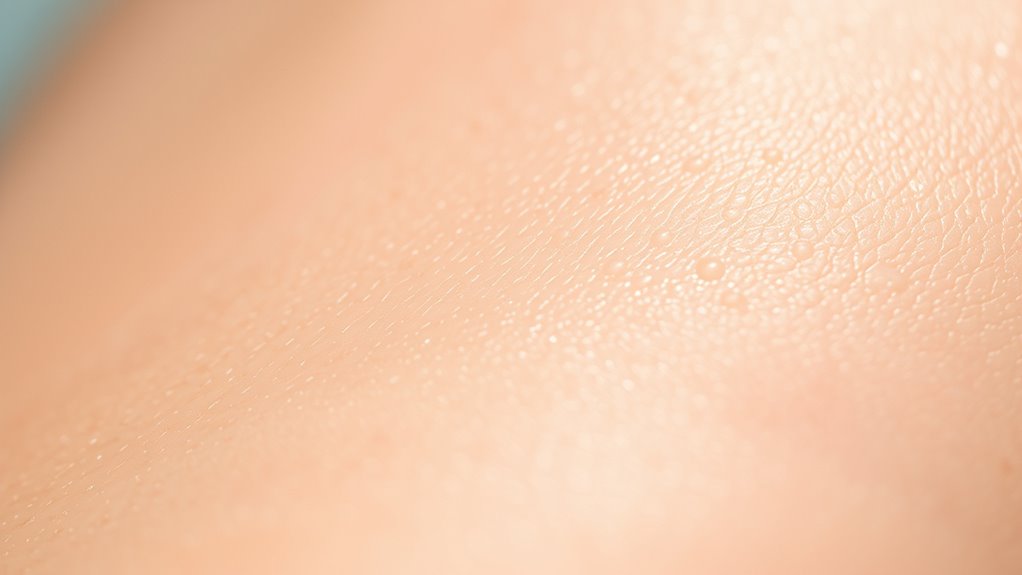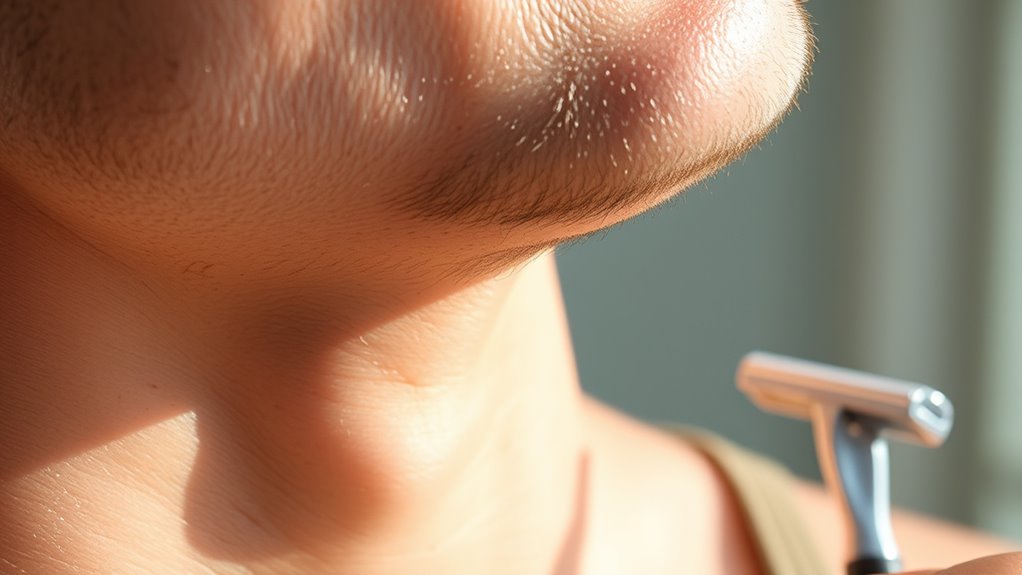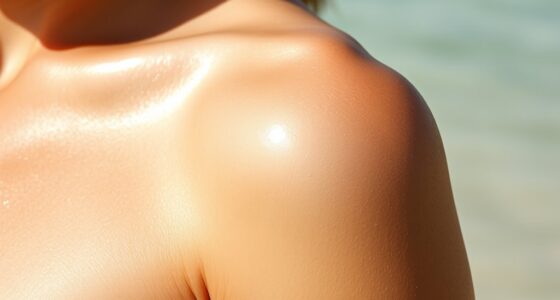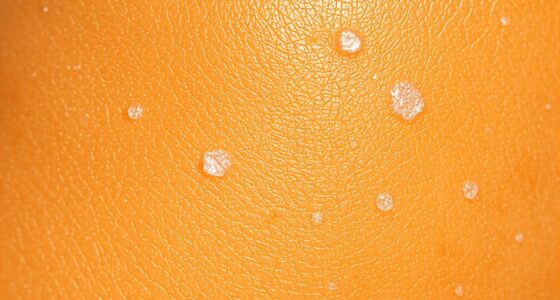To prevent ingrown hairs, start by properly preparing your skin before shaving. Exfoliate with gentle scrubs or washcloths once or twice weekly to remove dead skin. Shave after showering when your hair is soft and your pores are open, and always use a sharp razor. Applying a hydrating gel and shaving with the grain minimize irritation. Keeping your skin hydrated and following proper techniques are key—continue exploring ways to protect your skin effectively.
Key Takeaways
- Exfoliate skin regularly to remove dead cells and prevent hair from becoming trapped under the skin.
- Shave after showering or bathing when hair is soft and pores are open.
- Use gentle, non-irritating exfoliants and avoid harsh scrubs to protect skin integrity.
- Moisturize skin before shaving to reduce friction and skin irritation.
- Choose proper hair removal methods, such as using sharp razors and shaving with the grain, to minimize ingrown hairs.

Have you ever noticed a bump after shaving or waxing that becomes painful or inflamed? If so, you’re not alone. Many people experience ingrown hairs, which happen when hair grows back into the skin instead of outward. This often results in redness, bumps, or even pus-filled pimples. But the good news is, you can take steps to prevent ingrown hairs before you even pick up your razor or waxing strips. Prevention starts with how you prepare your skin and how you handle hair removal.
Prevent ingrown hairs by proper skin prep and gentle hair removal techniques.
First, guarantee your skin is properly exfoliated before shaving or waxing. Dead skin cells can clog hair follicles, making it easier for hairs to curl back and grow inward. Use a gentle scrub or a washcloth to slough off dead skin at least once or twice a week. When you’re ready to shave, do so after showering or bathing, when your hair is soft and the pores are open. Warm water helps soften hair and skin, reducing the chance of irritation and ingrown hairs.
Next, always moisturize your skin before shaving. Dry skin can lead to more friction and irritation, increasing the likelihood of hairs curling inward. Apply a hydrating shaving gel or cream that provides a smooth surface and allows your razor to glide easily. Using a sharp razor is vital—dull blades tug at the hair rather than cut cleanly, which can cause hairs to break under the skin and result in ingrowns. Replace your blades regularly, especially if you notice pulling or tugging during shaving.
When shaving, go with the grain of your hair rather than against it. Shaving against the grain might give you a closer shave, but it also raises the risk of hairs curling back into the skin. Use gentle, short strokes and avoid pressing too hard. After shaving, rinse the area with cool water to close the pores and pat dry with a clean towel. Applying an alcohol-free, soothing aftershave or moisturizer can help calm the skin and reduce irritation.
If you’re prone to ingrown hairs, consider alternative hair removal methods. Laser hair removal or depilatory creams might be less irritating than shaving or waxing, but always test a small area first. Wearing loose, breathable clothing after hair removal also helps prevent friction and irritation that can trap hairs under the skin.
Frequently Asked Questions
Can Ingrown Hairs Occur After Waxing or Only Shaving?
Yes, ingrown hairs can occur after waxing as well as shaving. Both methods can cause hair to grow back into the skin if the hair is broken or cut too close to the surface. Waxing pulls hair out from the root, which can sometimes lead to ingrown hairs if the hair follicle becomes blocked or if new hair grows at an angle. Proper exfoliation and skincare help prevent this.
Are There Specific Skin Types More Prone to Ingrown Hairs?
Yes, some skin types are more prone to ingrown hairs. If you have coarse, curly, or thick hair, you’re at higher risk because hair tends to curl back into the skin more easily. Also, those with oily or acne-prone skin may experience more ingrown hairs due to clogged pores and inflammation. To reduce risks, follow proper shaving techniques, exfoliate regularly, and keep your skin moisturized.
How Long Do Ingrown Hairs Typically Take to Heal?
Ingrown hairs typically take about a few days to a week to heal, depending on severity. If you notice redness, swelling, or discomfort, it’s essential to avoid picking or scratching, which can prolong healing. Gentle exfoliation can help to free trapped hairs, while applying soothing creams reduces irritation. Staying consistent with good grooming habits and keeping the area clean accelerates healing, helping you get back to smooth, snag-free skin faster.
Can Ingrown Hairs Lead to Infections or Scarring?
Yes, ingrown hairs can lead to infections or scarring if left untreated. When bacteria enter the inflamed area, infections can develop, causing redness, swelling, and pus. Over time, repeated ingrown hairs may damage your skin’s surface, leading to permanent scars. To avoid this, don’t squeeze or pick at ingrown hairs, keep the area clean, and use gentle exfoliation to prevent future ingrown hairs.
Are Natural Remedies Effective in Preventing Ingrown Hairs?
Natural remedies can be surprisingly effective in preventing ingrown hairs. Things like exfoliating with sugar scrubs, applying tea tree oil, or using witch hazel can work wonders. These remedies unclog pores and reduce irritation, making ingrowns less likely. While they might not be miracle cures, they’re gentle, affordable, and worth trying before resorting to harsher treatments. With consistent use, you’ll notice smoother skin and fewer ingrown hairs over time.
Conclusion
By taking these simple steps before shaving, you can substantially reduce the chances of ingrown hairs. Don’t worry if you’ve struggled before — prevention is all about consistency. Even if you think your skin is too sensitive, proper prep and gentle techniques make a difference. Start today, and you’ll notice smoother skin and fewer painful bumps. Remember, prevention isn’t just easier — it’s the key to confident, irritation-free shaving.









